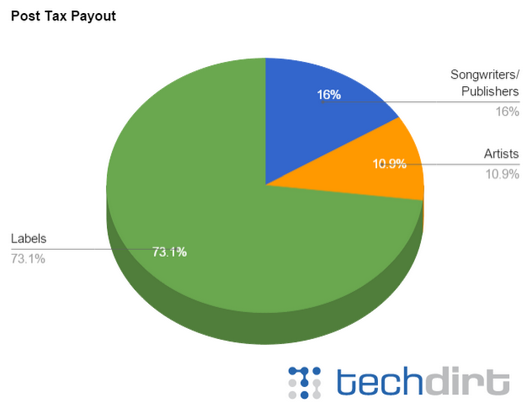Monday’s article in WIRED.com discussed two big winners of 2014: Taylor Swift and Spotify. Given Ms. Swift’s very public disagreement about royalties and other articles about small checks that some artists receive, many are left with the impression that music streaming services are unfairly benefiting from musicians’ work. Industry data emerged last week suggesting record labels are the real beneficiaries. This isn’t the first estimate to reach this conclusion, but it is the first from an auditor (Ernst & Young) and a recording industry trade group (SNEP of France) to confirm what was widely suspected.
Labels Retain 73% of Payouts, Artists Get Just 11%
An analysis of SNEP research by Music Business Worldwide and reported by Techdirt broke down the payouts. Spotify claims to pay out about 70% of revenue and other services have acknowledged paying out similarly high percentages. The SNEP article estimates that after payouts and French taxes, the streaming music services retain under 21% of all revenue, which must then be used to cover expenses. By contrast, record labels retain over 73% of all royalty payments after distributing 16% to songwriters and publishers and another 11% to the recording artists.

When streaming services such as Spotify talk about distributing $2 billion in royalty payments, the analysis suggests that $1.46 billion went to labels while $218 million and $320 million went to recording artists and songwriters, respectively. We had one party saying they had paid out a lot of money (streaming services) and another party saying they had received little (artists). As expected, the missing money wound up with the middleman (labels). It is important to note that the report focused on France and the royalty rates differ by country and by contract. However, this analysis closely matches other estimates of an artist’s compensation.
To be fair, the SNEP report also suggested that 95% of the labels’ take was consumed by expenses. Of course, those expenses include lavish perks and executive salaries that have been maintained despite a 50% drop in industry revenue. That same analysis suggests the streaming services have the smallest post-expense income at just 1% of revenue.
How does that make a villain out of streaming services? Artists should look first at their label contracts if they have compensation concerns. All evidence indicates that dollars are flowing to royalty holders with RIAA reporting that streaming services provided 27% of industry revenue.
Pitting Artists Against Streaming Services
In an attempt to shift the blame, labels seem to be happy to pit artists against streaming services. We hear a story or two about artists unable to make a living, but surprisingly we don’t hear the same story about record label executives. Are music industry executives suffering alongside the artists? Here is the take from Bono at the Web Summit Conference in Dublin last November:
“The real enemy isn’t between digital downloads or streaming. The real enemy, the real fight… is between opacity and transparency. The music business has historically involved itself in quite a considerable deceit… the record labels haven’t been transparent.”
 As the middleman, recording labels suggest the economics are out of their control. We see something else happening that is reminiscent of the industry’s crackdown on Napster. At that time, the industry went directly after Napster and used the artists as the engine of their PR campaign. Napster didn’t have any revenue at all, but the recording industry decided to take legal action and issue threats against over 20,000 individual music consumers.
As the middleman, recording labels suggest the economics are out of their control. We see something else happening that is reminiscent of the industry’s crackdown on Napster. At that time, the industry went directly after Napster and used the artists as the engine of their PR campaign. Napster didn’t have any revenue at all, but the recording industry decided to take legal action and issue threats against over 20,000 individual music consumers.
The tactic now is to deprive consumers of music on their favorite streaming services in an attempt exert pressure before contract renewals. However, the industry economics have fundamentally changed in the last decade. Shutting down Napster didn’t hurt the bottom line because it didn’t generate any revenue. Putting more pressure on the channel that delivers more than a quarter of industry revenue and is its fastest growing segment may be playing with fire. As we said in the Internet Radio Trends Report 2015, consumers have voted with their ears. Music streaming services are both the present and future of audio consumption.
Consult the Data for the Real Truth
There are a lot of numbers thrown around when it comes to music streaming and a lot of stories that choose those numbers selectively to make the payouts seem small. The website MusicAlly provides another perspective. It estimated in October and November 2014 that Taylor Swift was making $84,000 per week on Spotify from just one song, “Shake It Off,” when she pulled her music catalog from the service. At the time, Spotify estimated it was on pace to pay her more than $6 million in royalties. Most artists will never be able to take in that kind of revenue. Even if they could, it looks like the record labels would retain nearly three quarters of it.
Consumers want to use streaming music services and 55-70% of service revenue is already paid to royalty holders. Since the biggest slice of the pie currently goes to the record labels, the artists should look there first when they feel they’re not being appropriately compensated. And, it’s always worth noting that artists receive royalties on their plays from Internet radio and streaming services, while they receive nothing from broadcast radio. To anyone outside of the radio industry, that seems just as odd as the labels retaining more than six times what they pay out to artists.
Related Posts
WIRED Magazine – Big Winners of 2014: Taylor Swift and Spotify
Taylor Swift vs. Spotify: What Advertisers Need to Know
New York Times Misled by Recording Industry on Internet Radio
Streaming Growth is Not Undermining the Recording Industry
